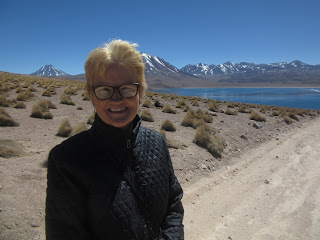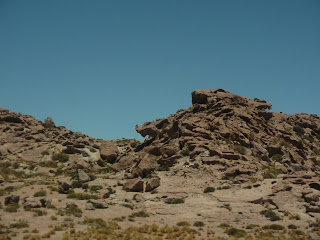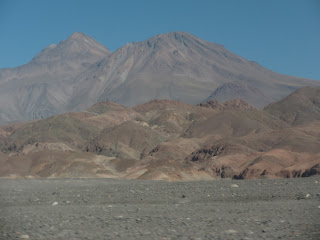Our last day in San Pedro de Atacama in northern Chile meant another day trip with Cosmo Andino Expeditions, the same company we'd already enjoyed two other trips with. Today's trip began with our being picked up at the more reasonable hour of 6:30 to travel to Reserva Nacional Los Flamencos. No, we weren't going to be learning the flamenco dance but seeing hundreds more flamingos!
After picking up other tourists from ten different hotels, we were finally on our way. Mauricio, our guide, said that with only ten percent humidity in the region, it was so much easier to see the stars. We could also have participated in an evening stargazing tour but the days had already been long enough with other tours.
I almost did not believe our tour guide when he told us we were going to visit flamingos in the middle of the desert. It would be incredibe to see such interesting wildlife in a place that looked like it could barely support life at all. It looked so much like a dusting or sprinkling of snow all around us. The white material was due to its being the Salar de Atacama, the third largest salt flat on earth.
The Atacama Salt Flat was located in a depression formed by the rising of the Andes and Domeyko mountain ranges. Over the years, a salt deposit with a maximum depth of 4,757' was formed from the precipitation of salts and minerals washed from the hills by the water flowing from the Andes toward the depression.
After picking up other tourists from ten different hotels, we were finally on our way. Mauricio, our guide, said that with only ten percent humidity in the region, it was so much easier to see the stars. We could also have participated in an evening stargazing tour but the days had already been long enough with other tours.
I almost did not believe our tour guide when he told us we were going to visit flamingos in the middle of the desert. It would be incredibe to see such interesting wildlife in a place that looked like it could barely support life at all. It looked so much like a dusting or sprinkling of snow all around us. The white material was due to its being the Salar de Atacama, the third largest salt flat on earth.
The Atacama Salt Flat was located in a depression formed by the rising of the Andes and Domeyko mountain ranges. Over the years, a salt deposit with a maximum depth of 4,757' was formed from the precipitation of salts and minerals washed from the hills by the water flowing from the Andes toward the depression.
The sprawling national reserve was located to the south and east of San Pedro de Atacama which had been our home for the last three days. Once we arrived at the parking lot at Laguna Chaxa, we had a longish walk down this road to the very salty lagoon where, according to Mauricio, we would come across lots of flamingos.
Years ago, tourists saw foxes next to the lagoon but the fauna had changed over time with the increasing number of tourists coming to the reserve. So many of the world's minerals were still concentrated in the salt flat, especially salt, borax and lithium. It was fascinating to find out that 45% of the world's lithium was produced here in the Atacama Salt Flat even though Bolivia had 90% of the world's quantity of lithium.
We were so fortunate that we were among the first groups of tourists there which meant there were so many flamingos on the edge of the lagoon or lake. Being springtime in the southern hemisphere meant that it was the beginning of reproduction time and therefore even more flamingos than usual on the lake. We were warned, though, to be especially quiet so the flamingos wouldn't fly away.
Mauricio quietly explained that Chaxa was home to three of the five known species of flamingos: the black-tailed Andean, the pink-tailed Chilean and James'.
The reflection of the flamingos on the water was out of this world. Judy: I hope you agree! Let me know which is your favorite photo so I can have a puzzle made for you as promised. Steven kept saying I already had enough photos of flamingos from the ones we'd already been lucky enough to see earlier in this trip but these just took my breath away and I couldn't stop snapping their photos.
Too heck with flamingo lawn ornaments - these were the real Mc Coy!
The view of the flamingos on the still lake was enhanced by the stunning volcano in the background.
Mauricio had mentioned earlier that the red-necked flamingos were macho males who stay in groups until they are chosen by females. After only remaining as a couple for one year, they then switch things up and find other partners. Female flamingos lay one egg a year for about twenty years.
The flamingos only mate within their species, i.e. Andean flamingos with Andean flamingos, Chilean flamingos with Chilean flamingos, etc.
I couldn't take my eyes off these enchanting, gangly pink "ballerinas" as they fed, slept with heads tucked under their wings and tiptoed through the water to test another potential feeding site.
We had been lucky enough seeing James' Flamingos while in Bolivia but didn't see any here. They come to Chaxa Lagoon in the winters when it's too cold further north in Bolivia.
As more people arrived and the noise levels increased, we could see the flamingos getting nervous and move away from the shore.
Spotting a few flamingos take flight was a spectacular sight!
I hadn't realized beforehand that the distinctive pink color comes from the 200 grams of shrimp the flamingos eat daily.
In the park's nature center, we saw some of the tiny shrimp the flamingos had feasted on in the lagoon.
After enjoying a delicious breakfast by the lagoon, we were back in the van as we still had many places to see on our tour which would encompass 500 kms or over 300 miles. I hated knowing we likely wouldn't be seeing any more of the flamingos I had so grown to love.
We were all instructed to drink lots of water to counter the effects of the altitude as we would be reaching over 13,000 feet altitude in a short time. Mauricio stated the vegetation would change every 500m because of the quantity of ash from the volcanoes we were passing!
The tiny red flowers we spotted were called Argentinian Flowers because the trucks coming from that country bring the seeds inadvertently on their trucks.
Even though the land looked very barren for agriculture, Mauricio said the principal crops grown here were blue potatoes, fava beans and small amounts of quinoa.
The terraces in the small village of Socaire acted like a natural filter which had worked well for a long period of time. When the government tried to introduce new farming techniques, the farmers resisted, preferring their old methods.
Mauricio explained the village had been reconstructed when it was damaged by earthquakes and that most of Socaire's inhabitants worked in lithium mines about 50 miles away.
A couple of minutes later, I noticed the Tropic of Cancer sign but the bus was past it before I could take a picture of it unfortunately. We were incredibly fortunate seeing field after field of lupines next as they only bloomed in November in that area of northern Chile.
I had never seen such a gorgeous field of wildflowers before. I've seen pictures of Texas Bluebonnets blooming in west Texas and could only imagine this was what they might have looked like. We've been through that area of Texas probably a good dozen times but never been lucky enough to be there when the state flower has been blooming.
The lupines' scent was intoxicating and only topped by the views of the salt flat and the majestic snow-capped volcanoes in the background. There had been lots of snow this past winter in this part of Chile called the Altiplano which resulted in an especially bountiful amount of lupines. Mauricio commented that if you talked to an old timer there was also four meters of snow - about 13' - forty years ago but far less than half that in recent years.
He joked the Altiplano wasn't the place to be in the wintertime for honeymooners as the minus 40 degrees Fahrenheit temperatures and the high altitude combined to make some things not work!
The driver slowed down so we could take photos of the vicuña grazing on the hillside. A member of the camel family, vicuñas normally live in groups with one alpha male and five females and their babies. No clothing can be made from their clothing in Chile.
Mauricio mentioned that when vicuñas are seen, pumas are generally nearby, too.
The town of San Pedro de Atacama where we had been staying and left that morning was at about 8,000' altitude; here we were almost 5,000' higher. We both had been drinking lots of water so the much higher altitude didn't affect us.
In the distance on the middle right was the last member of the camelid family, a guanaco that are normally only seen at lower altitudes. Otherwise, they only appear on restaurant menus, Mauricio commented!
A short while later we reached Miscanti Lagoon, the first of the two Altiplanico Lakes or high plateau lakes. At more than 14,200' altitude, the lakes are in a completely different climate to San Pedro de Atacama. The altiplanico is much more humid which meant that people are likelier to experience rain and snow in certain seasons but also far more wildlife and a stunning range of colors.
A sign indicated that the water in the Miscanti Lagoon was renewed by the seepage of rainwater and thermal groundwater. The surface in the winter is totally frozen when temperatures fall below zero.
As we walked toward the shore, we passed a climbers' hut as mountaineers try to ascend the 19,586' Miniques Volcano in the background.
With the bright blue water and matching skies, it was hard to imagine a prettier sight in the Atacama that sunny day.
This blackish area encircled by shrubs was a vicuña toilet! When the youngest male vicuña smells it, he knows how many females are around.
We spotted a trio of Black Giant Coots by the shore.
A look back at Miscanti Lagoon before hiking toward the next altiplanico lake, Miniques Lagoon or lake.
Miniques Lake, just a short stroll away from its sister lake, was home to many birds and occasionally flamingos but we didn't spot either that day. Though much, much smaller than its neighbor, it was just as beautiful. Both lakes were an amazingly deep blue. Mauricio stated Miniques - the little lake - receives subterranean water from Miscanti - the large lake.
On the 45-minute drive to our final destination were incredible lava formations caused by volcanic eruptions.
Our first sight of the pastel-colored waters of the sprawling shallow lake known as Agua Calientes 2 and the soft gray hues of the volcanoes in the background looked a little spooky.
Again, we had a longish hike down to the water but the terrain here was far different than just a few miles away at the altiplanico lakes. Called the Salar de Talar, the Talar salt flat had strangely red colored formations known as Piedras Rojas or red rocks that required a very sure footing to navigate.
We needed to tread slowly on the rocks as the over 14,400' altitude was beginning to affect us. Perhaps it was also the lack of food since breakfast five hours earlier at Laguna Chaxa where we had seen the flamingos!
The coloring of the weather-smoothed rocks was somewhat muted when we visited because of higher than average rainfall. As we hiked through the unstable shale and sand mix to the edge of the lake for a better view, I thought this part of the world was among the most impressive regions I’ve ever seen for views of landscapes. I was so relieved that our extensive trip planning had led us to spend several days discovering the extreme wilderness and beauty around San Pedro de Atacama.
As we walked toward the shore, it was the windiest I ever remember experiencing and we often have exceptionally strong winds often in Colorado. Though the water temperature was a very pleasant 80 degrees, the air temperature with the wind chill was only 45 degrees.
It was so windy my teeth hurt when I smiled!
Thank goodness our driver and guide had found a spot well away from the fierce winds for us to enjoy a delicious picnic lunch. As it was 3 in the afternoon, it didn't take long for everyone to devour the food!
As we began the two-hour drive back to town, Mauricio said that was sulphur and not snow atop the volcano.
After an almost 12-hour day of seeing some of the most fantastic scenery and animals, we arrived back 'home' in San Pedro de Atacama at 6 pm. If you're ever thinking of spending time in Chile, the longest country in the world at 2,647 miles (in fact, the origin of the country’s name means “where the land ends” in the Mapuche indigenous language), I urge you to add the region around San Pedro de Atacama to your itinerary. You won't regret it, I promise you!
Next post: The big city lights of Santiago, Chile's capital.
Posted on April 7th, 2018, from Littleton, Colorado.



















































































Lupines grow here in Colorado in the same color of blue and other pastel colors. Lil Red
ReplyDelete